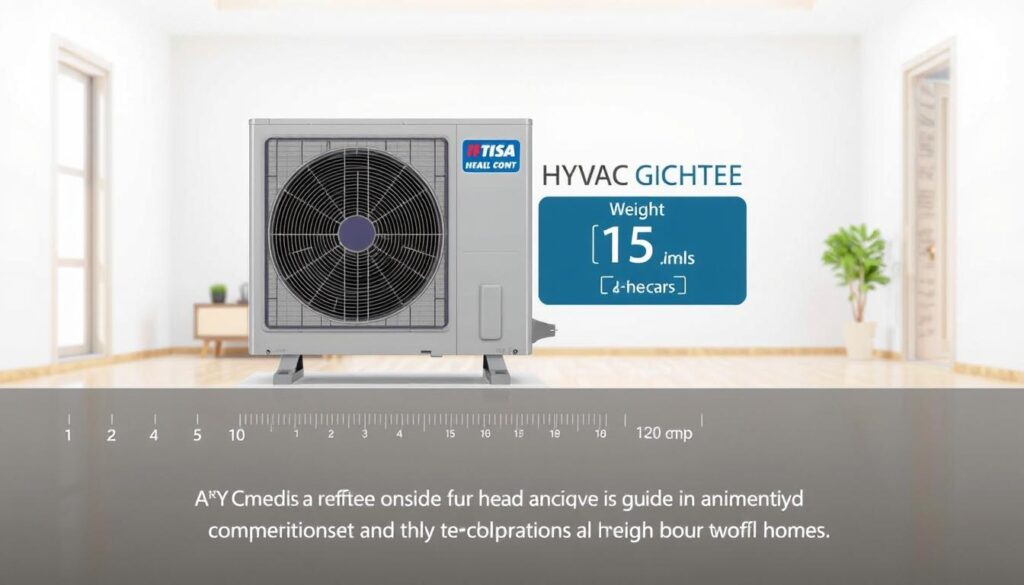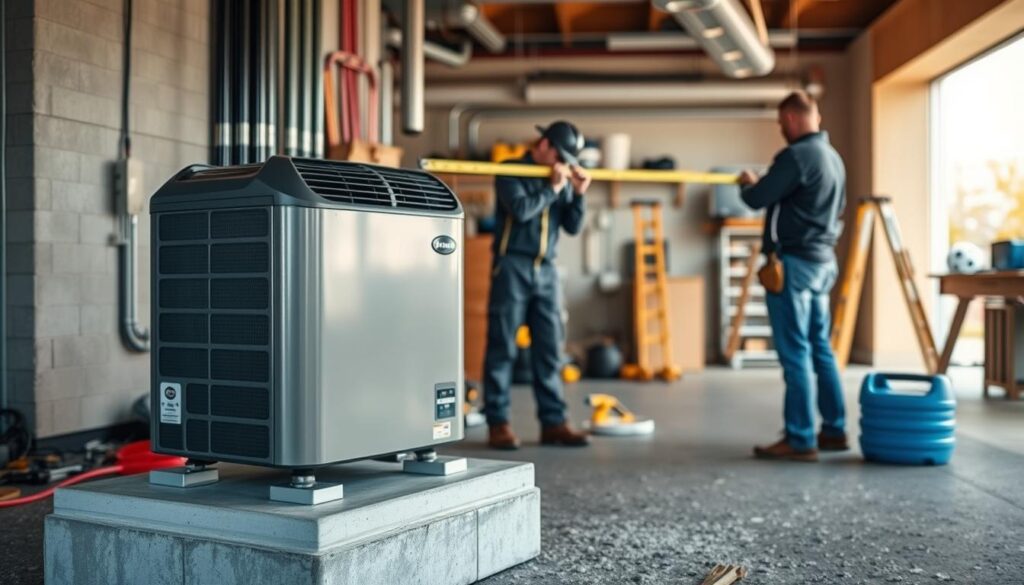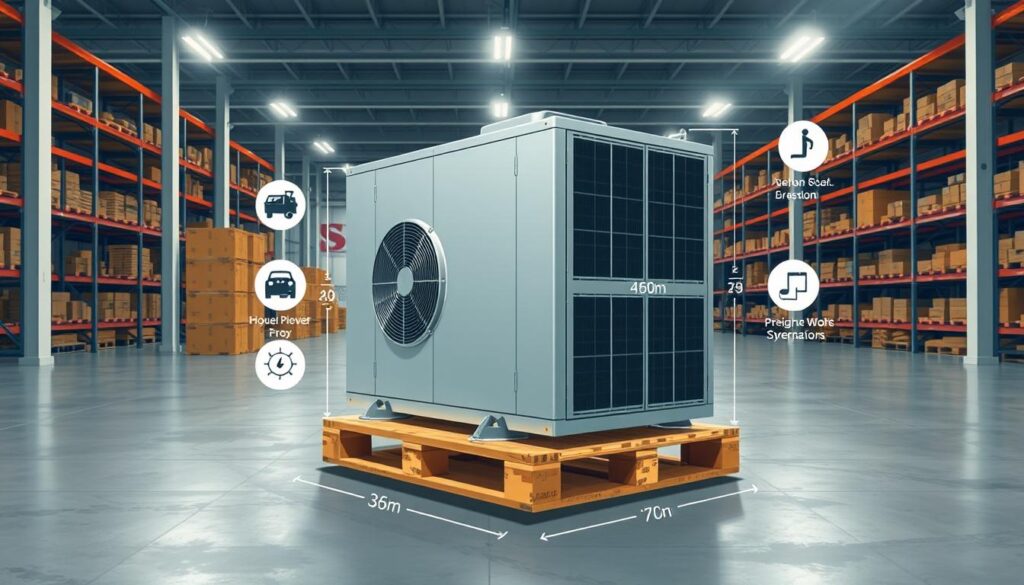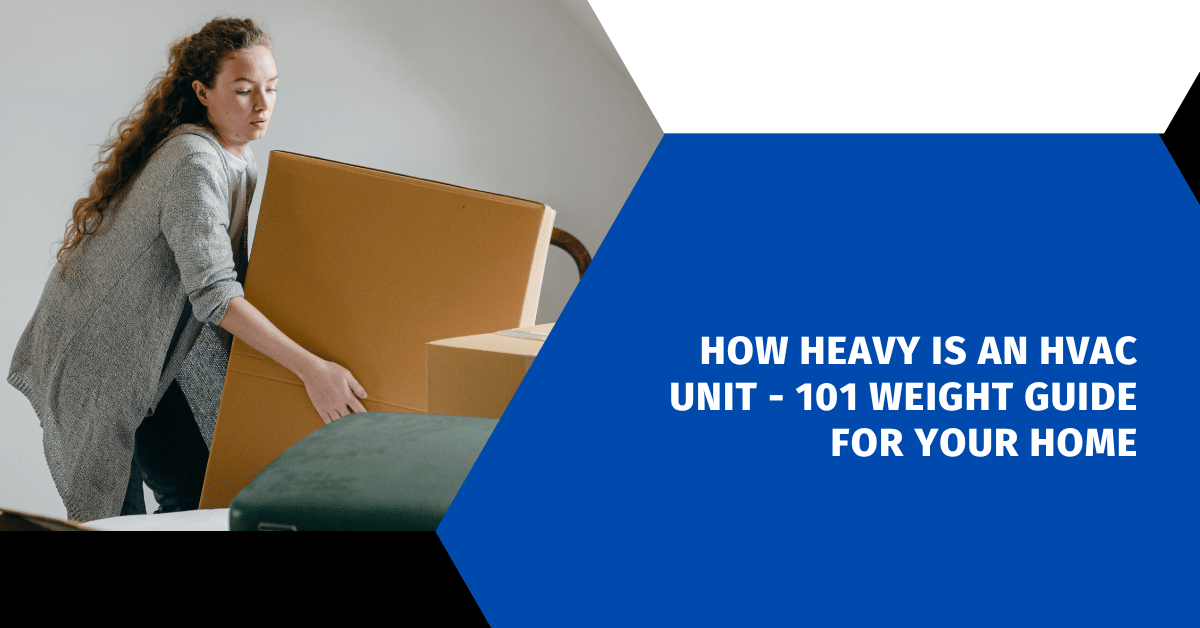Affiliate Disclosure
HVAC Guide Guys is a participant in the Amazon Services LLC Associates Program, an affiliate advertising program designed to provide a means for sites to earn advertising fees by advertising and linking to Amazon.
How Heavy Is An HVAC Unit? Ever wondered how much your home’s cooling system weighs? Knowing the weight of an HVAC unit is more than just numbers. It’s about keeping your home comfortable, safe, and running well.

A typical air conditioner outside unit weighs between 150 to 210 pounds. But there’s more to the story. The weight of your home’s cooling system affects many things, like how it’s installed and how well it works over time.
When thinking about how heavy an HVAC unit is, there’s more to it than just numbers. The weight of the unit impacts how it’s moved, installed, and how well it works. It’s important for your home’s cooling system to be just right.
Key Takeaways
- HVAC unit weight varies significantly based on system type and capacity
- Residential units typically range from 150 to 210 pounds
- Weight impacts installation, transportation, and system performance
- Proper weight assessment is key for home cooling efficiency
- Different home sizes need different HVAC unit weights
Table of Contents
Understanding HVAC Unit Weight Basics
Exploring HVAC systems means knowing their weight and specs. This knowledge helps you choose the right cooling for your home. HVAC units have complex measurements and technical details.
HVAC system weight is more than just how heavy it is. It’s about how much cooling it can do, its size, and its weight.
Types of HVAC Systems and Their Weight Classes
There are different HVAC systems with different weights. Here are the main types:
- Central Air Conditioning Systems
- Ductless Mini-Split Systems
- Window Units
- Portable Air Conditioners
Factors Affecting HVAC Unit Weight
Several things affect an ac unit’s weight:
- Cooling Capacity (Tonnage)
- Materials Used in Construction
- Internal Components
- Energy Efficiency Rating
| HVAC System Type | Average Weight Range | Typical Cooling Capacity |
|---|---|---|
| Residential Central AC | 150-250 lbs | 1.5-5 tons |
| Ductless Mini-Split | 50-100 lbs | 0.5-2 tons |
| Window Unit | 40-80 lbs | 5,000-15,000 BTU |
Weight Terminology in HVAC Systems
It’s key to know HVAC terms. Tonnage is about cooling power, not weight. One ton is 12,000 BTUs of cooling per hour. So, a 3-ton unit cools 36,000 BTUs of heat from your home every hour.
“Knowing your HVAC system’s specs helps you make better cooling choices for your home’s comfort and efficiency.”
When picking an HVAC system, think about your home’s cooling needs. Consider insulation quality and energy efficiency to find the best unit.
Explore Our HVAC Shop
Looking for top-rated HVAC tools, parts, and accessories? Visit our shop and find the perfect solution for your needs.
Visit the ShopResidential AC Unit Weight Range
Knowing the weight of air conditioners is key for homeowners. This is true when planning to install or replace them. The weight changes based on the unit’s cooling power and design.
Residential HVAC units have different weights based on their cooling power. Most home air conditioners fall into a certain weight range. This range matches their BTU (British Thermal Unit) rating.
- Typical residential AC unit shipping weight: 150 to 210 pounds
- Cooling capacity range: 1.5 to 5 tons
- BTU range: 18,000 to 60,000 BTUh
The weight of an HVAC unit depends on several things:
- Cooling capacity
- System type
- Materials used in construction
- Additional features
AC Unit Weight by Capacity
| Tonnage | BTU Range | Approximate Weight (lbs) | Typical Home Size |
|---|---|---|---|
| 2 Ton | 24,000 BTUs | 150-180 | 1,000 sq ft |
| 3 Ton | 36,000 BTUs | 180-210 | 1,500 sq ft |
| 4 Ton | 48,000 BTUs | 210-240 | 2,000 sq ft |
| 5 Ton | 60,000 BTUs | 240-270 | 2,500 sq ft |
“Knowing your air conditioner weight helps ensure proper installation and structural considerations.”
When picking an AC unit, remember weight is just one thing. Efficiency, insulation, and expert advice are also key for best performance.
Explore Our HVAC Shop
Looking for top-rated HVAC tools, parts, and accessories? Visit our shop and find the perfect solution for your needs.
Visit the ShopHow Heavy Is An HVAC Unit for Different Home Sizes
Knowing the weight of an HVAC system is key when picking the right one for your home. The weight of an HVAC unit changes a lot based on your home’s size and cooling needs. Let’s look at how different home sizes affect HVAC unit weights.
Choosing the right HVAC unit is more than just looking at its weight. You must also match the system’s power to your home’s needs.
Small Home Units (Up to 1,000 sq ft)
Small homes need a lighter HVAC unit with less cooling power. Here’s what you can expect:
- Recommended unit size: 2-ton AC unit
- Average weight range: 150-250 pounds
- Typical BTU requirement: 18,000-21,000 BTUs
Medium Home Units (1,000-2,000 sq ft)
Medium-sized homes need bigger HVAC systems for better cooling. These systems are heavier to handle larger spaces:
- Recommended unit size: 3-4 ton AC unit
- Average weight range: 250-350 pounds
- Typical BTU requirement: 30,000-34,000 BTUs
Large Home Units (2,000+ sq ft)
Larger homes need the strongest HVAC systems. These units are much heavier and more powerful:
- Recommended unit size: 5-ton AC unit
- Average weight range: 350-500 pounds
- Typical BTU requirement: 34,000-48,000 BTUs
“Choosing the right HVAC unit is about finding the perfect balance between cooling capacity and system weight.” – HVAC Installation Experts
Remember, things like home insulation, climate, and local temperature changes can affect your HVAC choice. Always talk to a pro to find the best system for your home.
Window and Portable AC Unit Weight Guide
When picking a window or portable air conditioner, knowing the weight is key. These units are great for different spaces, weighing from 50 to 130 pounds. This depends on how much they can cool.
Window air conditioners have specific weights. This affects how easy they are to install and how well they work:
- Weigh between 50-130 pounds
- Cooling capacity from 5,000 to 12,500 BTUs
- Recommended for specific room sizes
Portable air conditioners are great for moving around. They usually weigh 50-80 pounds. This makes them easy to move from room to room. The air conditioner weight affects how easy they are to move and install.
“Choosing the right AC unit weight depends on your specific cooling needs and room dimensions.” – HVAC Experts
Different rooms need different BTU ratings and weights:
| Room Size | BTU Range | Approximate Weight |
|---|---|---|
| 150-350 sq ft | 5,000-8,000 BTU | 50-70 lbs |
| 350-550 sq ft | 8,000-12,000 BTU | 70-100 lbs |
| 550-1,050 sq ft | 12,000-18,500 BTU | 100-130 lbs |
Think about more than just weight when choosing. Look at energy use, noise, and how easy it is to install. Finding the right balance will cool your space best.
Understanding HVAC Tonnage vs Physical Weight
When you’re looking for an HVAC system, you’ll see two important measurements: tonnage and physical weight. These terms might seem confusing at first. But knowing them helps you pick the right HVAC unit for your home.
HVAC tonnage doesn’t mean the actual weight of your HVAC system. It actually shows how much cooling power it has. One ton of air conditioning equals 12,000 British Thermal Units (BTUs).
BTU Ratings and Their Relationship to Weight
BTU ratings help figure out the right cooling power for your space. Here’s how BTUs relate to tonnage:
- 18,000 BTUs = 1.5 tons
- 24,000 BTUs = 2 tons
- 30,000 BTUs = 2.5 tons
Cooling Capacity Measurements
Choosing the right HVAC unit is more than just looking at weight. You should also think about these important factors:
| Home Size | Recommended Tonnage | BTU Range |
|---|---|---|
| 800-1,000 sq ft | 2 tons | 24,000 BTUs |
| 1,200 sq ft | 3 tons | 36,000 BTUs |
| 2,000 sq ft | 5 tons | 60,000 BTUs |
“Choosing the right tonnage is key for efficient cooling and saving energy.” – HVAC Professional
A unit that’s too small won’t cool well, and an oversized one wastes energy by turning on and off too much. It’s best to get help from a pro to find the perfect HVAC unit for your needs.
Explore Our HVAC Shop
Looking for top-rated HVAC tools, parts, and accessories? Visit our shop and find the perfect solution for your needs.
Visit the ShopWeight Considerations for HVAC Installation

When you’re getting ready for an hvac installation, knowing the unit’s weight is key. The weight of your HVAC system affects many parts of the installation. This includes how it’s moved and where it’s placed.
“Proper weight management during HVAC installation ensures safety and optimal performance.”
Different HVAC units need different handling because of their weight. Home units usually weigh between 1.5 to 5 tons. Each weight has its own set of challenges for installation.
- Lightweight units (1-2 tons): Easier to maneuver
- Medium-weight units (2-4 tons): Require specialized equipment
- Heavy units (4-5 tons): Demand professional handling
Your installation team must think about a few important things when dealing with the weight of an HVAC unit:
- Transportation needs
- How many technicians are needed
- Tools for safe lifting
- Support at the installation site
Professional HVAC contractors have the right tools and methods to handle unit weight during installation. They check your space’s needs to place the unit safely and efficiently.
| Unit Weight | Installation Complexity | Equipment Needed |
|---|---|---|
| 1-2 tons | Low | Standard lifting equipment |
| 2-4 tons | Medium | Heavy-duty lifting machinery |
| 4-5 tons | High | Crane or specialized transport |
Tip: Always talk to professional HVAC technicians. They can make sure your unit is installed right, based on its weight and your home’s structure.
Structural Requirements for Different HVAC Weights
When planning an HVAC installation, it’s key to know the structural needs for different weights. Your home’s structure must handle the HVAC system’s weight well. This ensures it works right and avoids damage.
Roof Mounting Considerations
Roof-mounted HVAC units need a close look at the structure. They weigh between 800 to 3,000 pounds. It’s best if the unit doesn’t weigh more than 15-20% of the roof’s strength.
- Check the roof’s strength before putting it on
- Get a pro to test the roof’s load-bearing capacity
- Think about extra costs for strengthening the roof (10-25% of the total cost)
Ground Placement Requirements
Ground-level HVAC units have their own structural needs. They need a solid, level base for good weight distribution and to last longer.
| Unit Type | Typical Weight | Foundation Recommendation |
|---|---|---|
| Residential Split System | 300-450 lbs | Concrete pad, 4-6 inches thick |
| Commercial HVAC | 1,500-2,000 lbs | Reinforced concrete slab |
“Proper structural support is not an expense, but an investment in your HVAC system’s long-term performance.” – HVAC Installation Professional
Your HVAC installation must focus on structural integrity. A pro’s check ensures the system’s weight is right. This avoids damage and makes the equipment last longer.
Commercial HVAC Unit Weight Specifications
Commercial HVAC systems are much more complex than home units. They have different weights and cooling powers. The weight of your business’s air conditioner can vary a lot, depending on your commercial space’s needs.
When looking at commercial HVAC weights, there are key things to consider:
- Commercial units can range from 2 to 30 tons in cooling capacity
- The weight depends on the building size and cooling needs
- Light commercial units handle up to 25 tons
- Heavy commercial and industrial units go over 25 tons
The cooling capacity affects the weight of your commercial HVAC system. For every 350-400 square feet, you need about one ton of cooling capacity. This means installers must think about specific weight ranges.
A standard commercial HVAC unit can move around 600,000 BTUs per hour. This shows the big cooling power needed in commercial places.
Choosing the right air conditioner weight for your commercial space needs careful calculations. Things like how many people will be there, if there’s a kitchen, how many windows, and outside heat sources all play a part. They help figure out the right HVAC system for you.
Professional HVAC contractors use special methods like the transfer function method (TFM) from ASHRAE to find out exact cooling loads. This makes sure you get a system that fits your commercial space well. It also helps avoid wasting energy or hurting performance.
Explore Our HVAC Shop
Looking for top-rated HVAC tools, parts, and accessories? Visit our shop and find the perfect solution for your needs.
Visit the ShopTransportation and Delivery Weight Guidelines

When moving an HVAC unit, planning is key. Knowing the weight of your ac unit is important. It helps decide how to transport it and what equipment you’ll need.
Each HVAC unit’s weight calls for a specific transport plan. Light window units fit in standard vans. But, bigger commercial systems need flatbed trucks with special straps.
“Proper transportation ensures your HVAC system arrives safely and remains in optimal condition.”
- Small residential units (100-300 lbs): Compact vans or pickup trucks
- Medium commercial units (300-700 lbs): Flatbed trucks with secure tie-downs
- Large industrial systems (700+ lbs): Heavy-duty trucks with specialized loading equipment
Before your HVAC unit is delivered, keep these weight tips in mind:
- Check the vehicle’s weight limit before moving
- Use the right tools for lifting and securing
- Make sure the unit is tied down well during transport
| Unit Type | Weight Range | Recommended Transport |
|---|---|---|
| Window AC | 50-100 lbs | Standard cargo van |
| Residential Split System | 200-400 lbs | Pickup truck with secure tie-downs |
| Commercial HVAC | 700-1500 lbs | Flatbed truck with crane |
Professional delivery services know how to handle different HVAC unit weights. They make sure your investment gets to you safely and ready for setup.
Weight Impact on Installation Costs
When planning your HVAC installation, it’s key to know how unit weight affects costs. The weight of your HVAC system impacts transportation, labor, and installation costs.
The weight of your HVAC unit is a big factor in installation costs. Heavier units need special handling and equipment. This can raise your total installation expenses.
Equipment Transportation Fees
Transport costs for HVAC units change with their weight and size. Heavier systems often need:
- Specialized transport vehicles
- More labor for loading and unloading
- Higher delivery fees
Labor Requirements Based on Unit Weight
Heavier HVAC units need more complex installations. This affects your hvac cost in several ways:
| Unit Weight | Labor Complexity | Estimated Cost Impact |
|---|---|---|
| Light (Under 200 lbs) | Standard Installation | $500 – $1,000 |
| Medium (200-400 lbs) | Moderate Complexity | $1,000 – $2,500 |
| Heavy (400+ lbs) | Advanced Installation | $2,500 – $5,000 |
“The weight of your HVAC unit isn’t just a number – it’s a key factor in your total installation budget.”
Heavier units often need additional technicians, special lifting gear, and more time to install right. These factors can greatly increase your installation costs.
To cut costs, team up with skilled HVAC pros. They can give you accurate estimates based on your unit’s weight and installation needs.
Explore Our HVAC Shop
Looking for top-rated HVAC tools, parts, and accessories? Visit our shop and find the perfect solution for your needs.
Visit the ShopMaintenance Considerations for Different Weight Classes
HVAC maintenance changes a lot based on the unit’s weight and complexity. Heavier systems need more special care during maintenance and repairs. Knowing these needs helps protect your investment and keeps your system running well.
Different weight classes bring unique challenges for hvac repair and maintenance:
- Lightweight units (100-300 lbs): Easier to access and service
- Medium-weight units (300-500 lbs): Need more planning for maintenance
- Heavy commercial units (500+ lbs): Need expert skills and special tools
As unit weight goes up, so does maintenance complexity. Heavier systems often need more frequent checks by pros to avoid mechanical problems. Experts suggest yearly maintenance checks to keep your system running long and efficiently.
“Regular maintenance can extend your HVAC system’s lifespan by up to 40%”
Important maintenance tasks include:
- Checking refrigerant levels
- Inspecting electrical connections
- Cleaning air filters
- Evaluating system performance
| Unit Weight Class | Maintenance Frequency | Estimated Annual Cost |
|---|---|---|
| Lightweight (100-300 lbs) | 1-2 times per year | $150-$250 |
| Medium (300-500 lbs) | 2-3 times per year | $250-$400 |
| Heavy Commercial (500+ lbs) | 3-4 times per year | $400-$600 |
Regular hvac maintenance can save you money and make your system last longer. Always get help from professional technicians who know what your unit needs.
Conclusion
Knowing how heavy an HVAC unit is is more than just a simple weight check. It’s about making a big investment in your home’s comfort and energy use. When you’re looking to replace your HVAC, picking the right size and weight is key for the best performance.
The weight of your air conditioner affects how well it cools, how much energy it uses, and how well it works. A smaller unit might seem cheaper at first, but it can cost more in the long run and work less efficiently. Experts say to match your unit’s size to your home’s size to avoid problems like short cycling and uneven temperatures.
Your HVAC unit’s success depends on getting the size right and installing it correctly. Regular upkeep, like changing filters and getting your system checked twice a year, can make it last longer. Knowing how weight, cooling power, and home needs are connected helps you make smart choices for comfort, energy, and saving money.
Getting advice from HVAC pros who know your home’s needs is the best way to choose the right unit. They can help you pick a system that cools your home well and lasts for many years.

